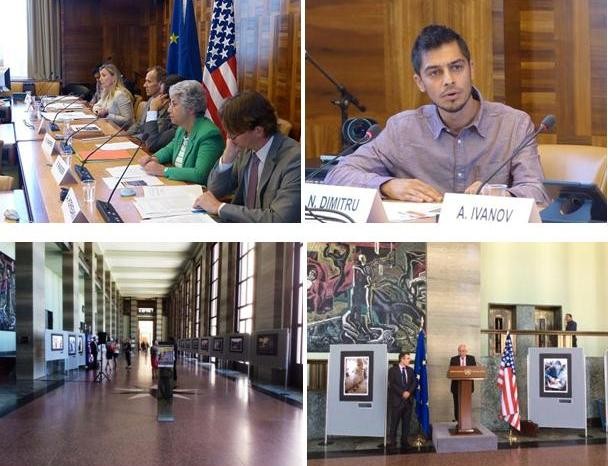In the opening statement, Ambassador Mariangela Zappia, Head of the EU Delegation to the UN in Geneva explained the rationale behind the event:
"The Roma persons are an integral part of our social fabric. Of an estimated 10-12 million in the whole of Europe, around six million live in the EU. Despite our governments' longstanding efforts to uproot discrimination, some of them continue to be victims of prejudice and social exclusion. We fully recognise that more needs to be done to make sure that Roma persons can enjoy the same rights, the same life opportunities, and realise their potential.” Moreover, she added:
"The European institutions and each of our 28 Member States have a joint responsibility to improve the lives of the EU’s Roma citizens. We are very active on this issue, which is addressed as a priority both at the national level and in regional organizations." Indeed, in 2011, the European Commission asked all of EU Member States to develop national strategies for Roma integration, with concrete policies and measures. The Commission will assess progress every year until 2020. This process also takes into account input from civil society organisations, NGOs, as well as international organisations and the EU Fundamental Rights agency.
Keith Harper, US Ambassador to the UN Human Rights Council, pointed out that
” the US is the state with the largest population of Roma descendent in the world and we are proud of their contribution." However, Ambassador Harper also acknowledges that there are specific challenges in the protection of the human rights of Roma persons.
Rita Izsák, UN Special Rapporteur on minority issues, identified some of these challenges Roma persons still face worldwide in her statement: Education, housing, employment, health care, lack of identity documents, lack of social security, hate speech, challenges to free movement, racism and racist violence. Yet, she also emphasized positive developments:
”There is an unprecedented number of Roma youth in higher education, also thanks to various scholarships and mentorships schemes. There are many who successfully work in the corporate sector or in government offices. We have a growing number of Roma middle-class and intellectuals, who can be the real leaders of their own communities if discrimination, racism and prejudice doesn't prevent them."
Flavia Pansieri, Deputy High Commissioner for Human Rights, recognized the political efforts and initiatives underway to address the situation of Roma persons, but she also pointed to a mental change of mind that needs to happen:
"One characteristic of discrimination and prejudice is denial – the reassuring cliché that Roma have the same rights and opportunities as everyone else, so that that any failure to progress on their part is essentially, in some ill-defined way, their fault. In reality, for Roma growing up in urban or rural ghettos – often in dramatic poverty, with sub-standard and sometimes segregated education and facing widespread discrimination – opportunities for advancement are often extremely restricted. Only once we acknowledge that they face specific obstacles can we then make a vigorous, concerted and effective effort to eliminate those barriers – an effort that must involve national, regional and local authorities as well as the media and the Roma themselves." For Ms Pansieri, the need to better involve the Roma communities in this process is of utmost importance.
"They must be active authors of each policy intervention, not merely its passive objects. As rights-holders, the Roma must assist in the design, implementation and evaluation of all projects that are intended to benefit their own communities. Too many top-down projects do not adequately consult the Roma communities whose situation they aimed to address, and achieve problematic results."
Antti Korkeakivi, Chief of the Indigenous Peoples and Minorities Section of the UN Office for Human Rights added that for OHCHR this process of monitoring the participation of decision-making at local level is a priority.
The better inclusion of Roma communities in the policy process was also highlighted by Nicu Dumitru, a young Roma human rights defender from Romania. He addressed in particular the role of NGOs and civil society organisations working on the human rights of Roma persons.
"I see a sort of paradox in this regard: We have probably the most educated population of Roma in history, and yet I have the feeling that their voices get weaker."
Andrey Ivanov, who heads the Roma and Migrant Integration Sector at the European Union Agency for Fundamental Rights, also identified challenges at the grass-root level:
"The role of the implementation at the local level is very important. In the gender debate, there is the terminology of a 'glass ceiling'. We have a similar 'glass floor' when it comes to Roma inclusion projects. There are a lot of resources and a lot of efforts put in, but somehow when things go down to the local level there is this glass floor which prevents the resources to reach the right people," he explained.
The event, which was moderated by Mark Lattimer of the Minority Rights Group, was followed by the opening of the photo exhibition
The Roma – from ‘extra’ to ‘ordinary’ in cooperation with the Romanian Cultural Centre in London.
The exhibition was introduced by Nicolae Ratiu (Chairman of Ratiu Family Foundation and Director of RCC) and Dominic Porter (Deputy Head of the EU Delegation).
The exhibition, part of a larger project exhibited in London earlier this year, highlights prejudices against Roma persons and the ordinariness of their reality and will be shown at the UN Palais des Nations from 12 – 19 September 2004.
For more details about the event please click
HERE.
